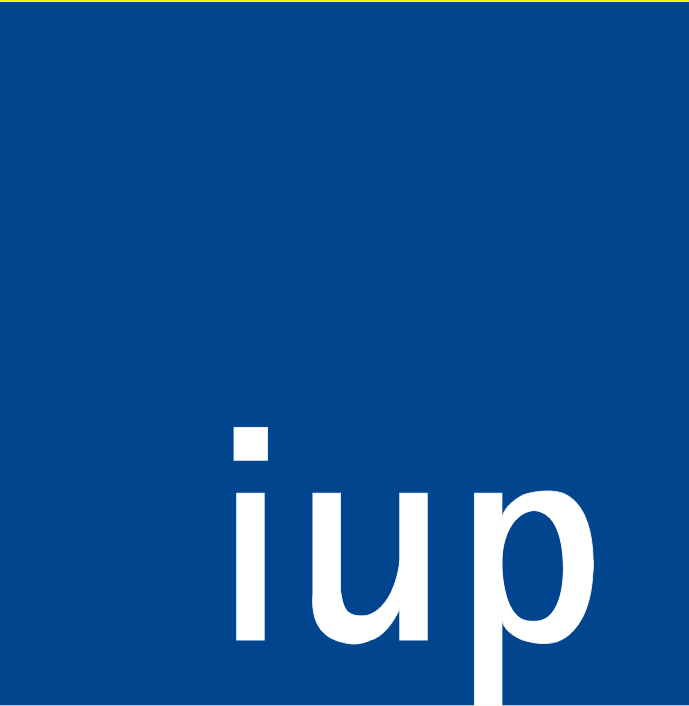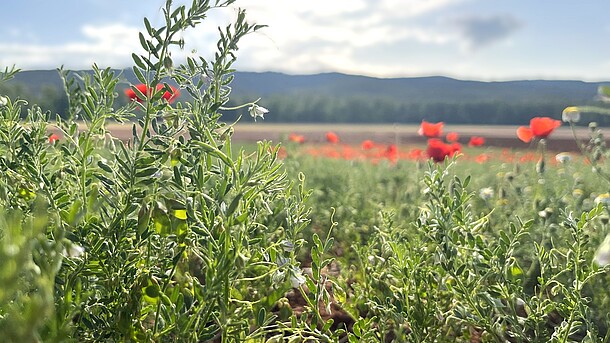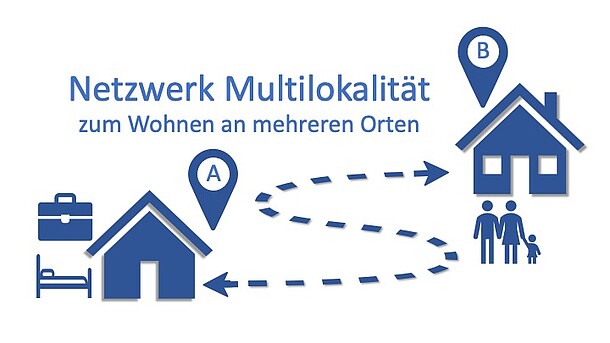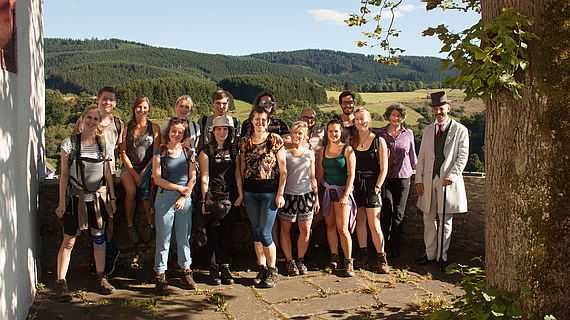
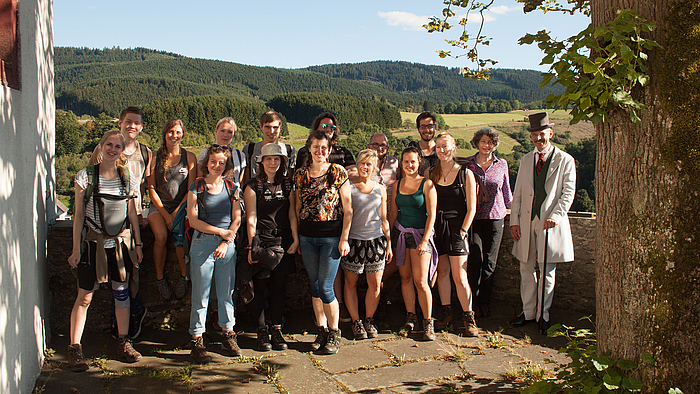
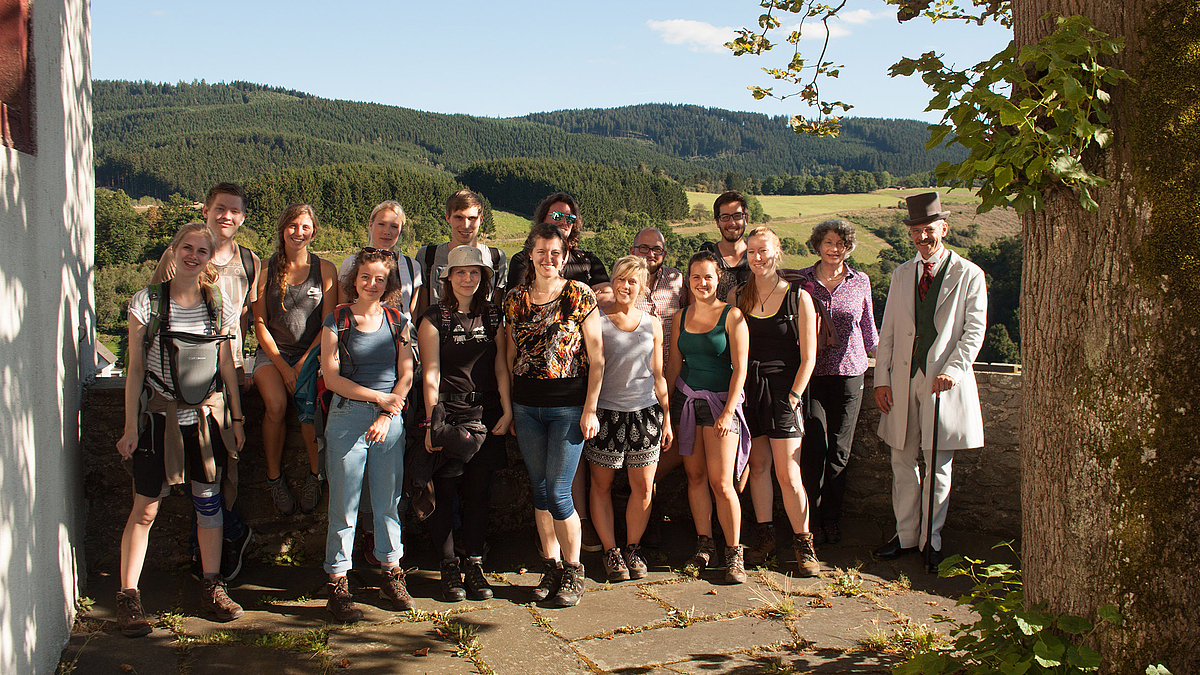
From 29 August to 2 September 2016, fourteen students and their lecturer Roswitha Kirsch-Stracke were on the road in the Sauerland-Rothaar Mountains Nature Park to look at projects in nature conservation and monument preservation, rural cultural work, tourism, village and regional development. The entire excursion took place by train and bus - and on foot.
On the first day, the group visited the Department of Fishery Ecology of the LANUV (NRW State Office for Nature, Environment and Consumer Protection) in Kirchhundem-Albaum. Here, numerous tasks of the office were explained and the students were guided through the fish breeding facilities. It was interesting to hear details about the migratory fish programme and how certain fish species of natural flowing waters can be reintroduced into native waters through breeding and monitoring.
Afterwards, the group went shopping at the Albaum village shop "Aldo", a project of the village community. Here the group bought food for their five-day stay. Albrecht Sandholz, chairman of the local heritage and development association, vividly presented the challenges and successes involved in opening the village shop. The students were impressed by the courage and ambition of those who brought the village shop to life.
After a long day, the charming backpackers' hostel in Kirchhundem-Heinsberg awaited the group. Owner Christoph Henrichs, chairman of the Dorf AG Heinsberg, reported on the history of the more than 200-year-old half-timbered house as well as its conversion into a hostel in 2000. Dinner was prepared together in the self-catering kitchen and the first day was able to end in a cosy atmosphere.
Early the next morning, the group drove to Grevenbrück, where Engelbert Stens and Manfred Kuhr, both involved in the Heimat- und Verkehrsverein Grevenbrück e.V., guided the group through the museum of the town of Lennestadt (Museum der Stadt Lennestadt). The focus was on the history of the medieval Peperburg. This was followed by an ascent to the Peperburg ruins, where the students carried out wall maintenance by selective weeding: Woody plants that could burst the wall through their thick growth were removed, while herbaceous plants typical of the site were allowed to continue growing. All wall plants were recorded, botanically identified and noted. The students determined that weeding on the walls should be done a little more often than it has been in the past in order to better preserve the ruin. As a reward for their work, they had a delicious lunch: Pea soup with sausages. In the afternoon, the group drove on to Bilstein. Here Günter Sagafe, a member of the association Landschaft lesen lernen in Südwestfalen – Netzwerk Kulturlandschaftsführer/innen e.V. (Learning to Read Landscape in South Westphalia - Network of Cultural Landscape Guides), led a tour up to the castle, which has served as a youth hostel for a long time. He explained the history of the castle and explored the traces of the terraced gardens on the castle rock with the students.
On Wednesday, the group visited the wood and tourism centre in Schmallenberg. Here, project manager Susanne Falk gave them an introduction to the REGIONALE project "Paths to Life" (REGIONALE-Projekt „Wege zum Leben. In Südwestfalen“). In South Westphalia". The students were impressed by the acceptance and openness of the population towards foreign cultures and religions that became clear in the project. Afterwards, the group walked to Wormbach, the oldest parish in the Sauerland. Here a meeting was arranged with Johannes Tigges and Anette Gerbe, both involved in the Hawerland e.V. association, as well as Andreas Dicke, technical councillor of the town of Schmallenberg. The discussion was about village renewal and the redesign of the village centre, for which eight students were to develop a concept within the framework of a week-long impromptu. Johannes Tigges gave an exciting lecture on the Wormbach church and the mystical history of the village. Afterwards, the students were able to explore the place independently. Some of them dealt with the old churchyard wall. Here, as on the previous day, they weeded selectively and found that renovation and better maintenance of the wall would be urgently needed to preserve the historic enclosure of the churchyard. The results of the week's impromptu will be presented in Wormbach at the end of October.
On Thursday, the group was out and about in the municipality of Kirchhundem. By bus they went to Wirme and from here on foot to Silberg, where the guests were welcomed to the Schrabbenhof cultural estate by Ulrike Wesely, MuT Sauerland e.V.. The origins and development of the cultural estate were explained as an example from the "Museum Development Plan for the District of Olpe". On site, the current work with young locals and refugees was impressive. A coffee table with fresh waffles from the café of the cultural property rounded off the visit. Some students bought memorabilia in the Schrabbenhof's junk shop.
Afterwards, the group hiked through the NSG Dollenbruch (Nature reserve) . On the way, traces of mining and special biotopes of the protected area, such as orchid meadows and coppice forests, were addressed.
On the last day, there was enough time to explore the village of Heinsberg (Dorf Heinsberg) along the former railway line. Three students developed proposals for open space design around the backpackers' hostel in a one-day impromptu.
At the end of the excursion, the impressions of the week were discussed together. The students were enthusiastic about the five days spent in the Sauerland. What impressed them most was the ambition of the volunteers and private individuals, their commitment to the development of the places and communities, and the open-mindedness of the population.
Text: Lisa Berger and Anna Muhrman
Press reports
